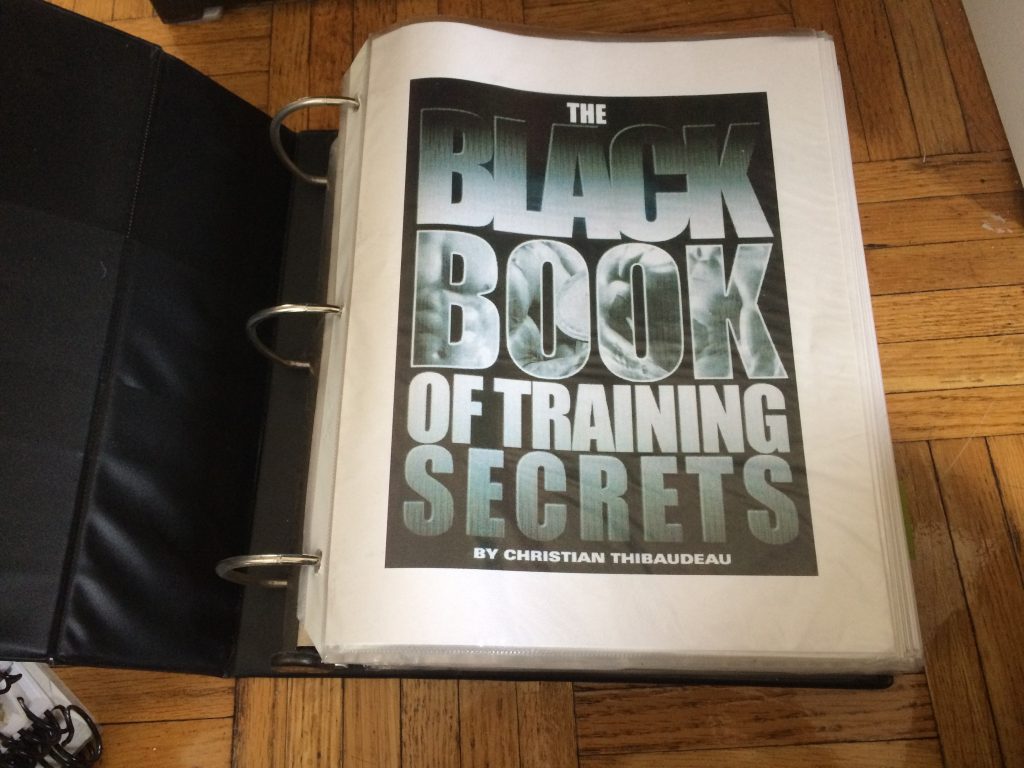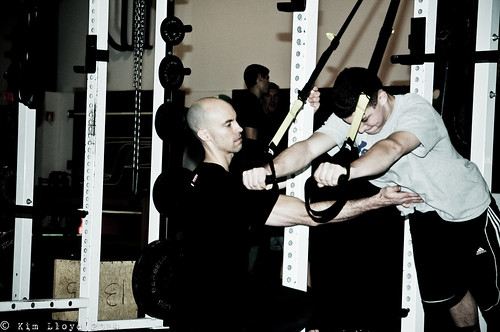NOTE TO READER: This is a re-post of a blog post I wrote back in 2017. It’s still the shit. You should read it.
There aren’t many topics harder to write about than program design.
I mean, I guess we can make a case for Biomolecular Feedback Systems or the intricacies of Mass Spectrometry,[footnote]Everyone knows it involves introducing enough energy into a target molecule to cause its ionization and disintegration. The resulting fragments are then analyzed, based on the mass/ charge ratio to produce a “molecular fingerprint.” DUH! What’s next? Telling me you don’t know the Vanderwaals radius of Niobium?[/footnote] but in my neck of the woods – health/fitness & increasing people’s general level of badassery – program design can be (and often is) an arduous topic to break down.
It’s often a rabbit hole full of platitudes and people majoring in the minors.

I don’t know how many sets your client should perform. Or reps. And I don’t know if back squats would be a better fit than front squats.
The answer to any programming question will always be “it depends.”[footnote]And that bacon is delicious.[/footnote]
Did Tony Just Say Program Design is Dumb and Useless?
Um, no.
What kind of coach would I be if I said that?
Of course it’s important. I’d also be remiss if I didn’t say it’s imperative for any personal trainer or coach to be competent in that area and have skills.
A particular set of skills.
Skills that make you a nightmare for excess subcutaneous fat and sub-par deadlift technique.
^^^^ See what I just did there? ^^^^
There aren’t many things more simultaneously rewarding and frustrating than writing training programs for people
Emotions can range form “yep, I nailed it, my girlfriend will be in the next Olympics” to “fuck my life, I suck at writing programs.”
Moreover, if we were to be honest, and if we really think about it, nothing is more hypothetical than writing programs for people.
It’s all a guessing game.
I’m serious, I can think of several things less hypothetical than writing programs for people:
- A Sasquatch.
- A 14 hour orgasm.
- Lightsabers.
- A good Transformers movie.[footnote]We can MAYBE make a case for the first one. After that, they’re garbage.[/footnote]
Sets, reps, which exercise to do, and in what order?…it all falls under the umbrella of “I think this will work.”
“I’m pretty sure this person should trap bar deadlift instead of using a straight bar.”
“11 reps, Definitely 11.
“Shit, did I leave the oven on?”
I mean, hopefully your guesses aren’t coming from left field and made with some modicum of education catered to the goals, needs, and experience level of each client/athlete you work with.
There are a multitude of factors to consider when writing a program. There’s no such thing as a one-size fits all approach.
It’s something entire books take 500+ pages to explain and people get fancy degrees in and stuff.

One of my all-time favs: Christian Thibaudeau’s Black Book of Training Secrets
I am not going to get into the nitty-gritty of program design in this little ol’ post. I’ll peel back that onion at a later date. But there are several tenets of program design that are widely accepted across the board.
Including but not limited to:
Periodization
The organization of the training process. More to the point: It’s the planned variation in training volume and intensity over the course of a training program
This can be accomplished using Micro, Meso, or Macro Cycles:
- Micro – Usually one-week in length
- Meso – Usually 2-8 weeks in length, and often the most utilized.
- Macro – Usually one-year in length (typically reserved for competitive athletes and/or SuperHeroes.
Mesocycles (2-8 week blocks) are the most common and can often be broken down into specific categories:
1. Doing Stuff. Or, What Uppity Strength Coaches Call General Physical Preparedness (GPP)
This is a phase where most people will start and it entails improving things like ROM of a particular muscle, flexibility, strengthening of weak muscle groups, addressing movement quality deficits, and using it as an opportunity to teach proper technique on certain exercises and drills.
2. Specific Physical Preparation (SPP)
My good friend, Joe Dowdell, often says this is where the bulk of the general population – particularly those who work with personal trainers – will stay.
This phase can have one of two focuses:
- Accumulation – where the main stressor is volume (strength endurance, hypertrophy, etc)
- Intensification – where the main stressor is intensity (Max Strength, Relative Strength, Speed Strength, Strength-Speed, etc)
3. Specific Training Phase
This is most often reserved for athletes and honing in on the specific demands of their sport of choice. Everything from exercise selection, speed of movement, energy-system work is specific to the sport.
4. Competitive Phase
In short, this covers IN-SEASON training. When I was at Cressey Sports Performance how we programmed for a baseball player during his IN-season training drastically differed from his OFF-season, mostly in terms of training frequency and intensity.

Types of Periodization
Giving credit where it’s due, the bulk of these descriptions are taken from Joe Dowdell’s Program Design Manual.
[NOTE: Sorry, good luck finding it. You’ll have better odds at finding The Invisible Book of Invisibility.]
1. Sequential Method (Linear)
This method uses specific intervals of time in order to develop a singular goal or strength quality.
This is where many beginner clients will start (as well as those who are injured).
- Long Linear Method – Beginners live here. As weeks pass, volume decreases as intensity increases. The concept of “do more work each week” is hammered home here.
- Short Linear Method – Uses 1-3 weeks and tries to fix the shortcomings of long-linear approach. Is a way to prevent de-training of strength qualities.
You can also think of this method as NSCA Essentials 101:
Preparation —> Hypertrophy —> Strength —> Power —> Competition —> Active Rest
The pitfall, unfortunately, is that this approach isn’t optimal for more advanced lifters/athletes as it’s tough to train multiple qualities at once.
2. Undulation Method
This is a very popular method and one I use often with my own clients. This is where you perform several different workouts in a repeating cycle, focusing on a different rep-range, exercises, or both.
A classic example is something like this:
Day #1 = “Heavy” Day; where all exercises are performed with low(er) repetitions (3-5) using heavier loads.
Day #2 = “Medium” Day; where all exercises are performed with more traditional “hypertrophy” styled rep-ranges (8-12)
Day #3 = “Light” Day; where all exercises are performed with high(er) reps (15+), tickles optional.
The above approach can be a considered “Daily Undulation.” You can also implement a weekly undulated approach, where the training stress fluctuates weekly.
All in all it’s a nice way to keep training fresh and allows trainees some variety.
3. Concurrent Method
This method allows for training multiple qualities at the same time in a given time period. The most common examples of this method is Westside Barbell and CrossFit.
Westside Barbell = Max Effort Method, Repetition Method, Dynamic Effort Method.
CrossFit = Wall Balls, Kipping Pull-Ups, Double Overs, and Running Over Your Left Arm with a Prius for AMRAP. Dope.
4. Conjugate Method
This is a variant of Concurrent programming. Here, you’re still training multiple qualities but with an emphasis on ONE goal while maintaining all others with a minimal volume.
5. Block Periodization
This is described as a linear series of blocks that focus on several abilities at once. For high-level athletes and competitors this seems to be the preferred approach.
With this method there’s one dominant quality being emphasized (maximal strength for example) with a secondary focus on a different quality (muscle hypertrophy, bringing sexy back), all using a sequence of meso-cycles:
Accumulation (4 weeks) – develop basic abilities such as general aerobic endurance, muscle strength, movement quality, etc.
Transformation/Intensification (4 weeks ) – develop specific abilities like anaerobic endurance, specialized muscular endurance, and event specific technique.
Realization (2 weeks) – pre-competition, which typically emphasizes maximum speed and recovery prior to event. Otherwise known as “you’re now ready to go rip shit up.”
The Training Hour Pie
Mike Boyle speaks to this often. If you have a finite amount of time with a client or athlete – say 60-90 minutes – it’s important to structure each training session to fit the goals and needs of the person and prioritize a certain percentage of the pie accordingly.
That’s the meat-and-potatoes of (good) program design.
Most programs, day-to-day, breakdown as follows:
- Soft Tissue Work – 5-10 minutes
- Mobility Work/Dynamic Warm -Up – 5-10 minutes
- CNS, Reactive, or Speed Work – 10-15 minutes (jumps, skipping, agility, plyometric, OLY Lifts)
- Strength Training – 30-40 minutes
- Energy System Work – 10 minutes
- Recovery & Regeneration – 5-10 minutes.
- Netflix & Chill – optional (but not really)
There will be fluctuations in how much time you allot to what component person-to-person. Some may need to spend more dedicated time on tissue quality, while others may need to up their conditioning.
However, it’s well accepted that most training sessions should follow this “flow,” and it’s your job as the coach to figure out the details.
All of This to Say
When I’m asked to speak to undergrads or young fitness professionals I often balk at the idea of discussing program design. I refrain from writing about it, too. They all want the answer, the big idea, the overarching thesis.
It’s impossible to do.
It’s all talk.
Stop talking.
Don’t get me wrong, the talking is important. It behooves any aspiring fitness professional to have a base understanding of anatomy, physiology, exercise science, and biomechanics and to talk things out.
To speculate, pontificate, question, maybe proselytize.
It’s also important to, you know, read books. I’d never say otherwise.

But it’s also important to consider that reading, talking and pontificating – while part of the “Turning Pro” process – doesn’t in any way, shape, or form suggest mastery.
Action does.
I’d argue the best way to write effective programs is through experience and letting yourself marinate in trial-and-error.
Honestly, when it comes to writing effective training programs, trial-and-error via experience will teach you more than most textbooks.
— Tony Gentilcore (@tonygentilcore1) April 25, 2017
It’s not necessarily about how many books you read, seminars on the topic you go to, or how many “Masterminds” you attend. That’s all well and good and does matter. But having the guts to finally break the inertia of inaction, to finally stop talking, and to finally put things into action (often failing miserably)…that’s when things get interesting.
And when the not sucking begins.



